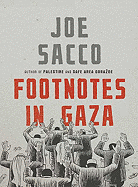
.
 There's no name for the genre of Joe Sacco's Footnotes in Gaza because Sacco has invented his own and is its sole practitioner. Call it graphic reportage or graphic journalism, it's investigative reporting done in comic book format, in a crisp, ultra-realistic style bringing a visual message as well as a verbal one, and this 400-page masterpiece is equally exhilarating in its artwork and harrowing in what it has to say.
There's no name for the genre of Joe Sacco's Footnotes in Gaza because Sacco has invented his own and is its sole practitioner. Call it graphic reportage or graphic journalism, it's investigative reporting done in comic book format, in a crisp, ultra-realistic style bringing a visual message as well as a verbal one, and this 400-page masterpiece is equally exhilarating in its artwork and harrowing in what it has to say.
The creation of the book began in 2001, when a mention of two little-known large-scale killings of civilians in the Gaza Strip in 1956, the greatest massacre of Palestinians on Palestinian soil, was edited out of an article the author and Chris Hedges turned in to Harper's magazine. To right that wrong, Sacco returned to Gaza to gather 50-year-old information on these two "footnotes" of history, which he then brought to terrifying visual life.
Swiftly and skillfully Sacco draws the reader into the tortured world of the Gaza Strip, using his present-day return to Gaza as a documentary framing device for what obsesses him, the slaughter inflicted by Israeli soldiers on the men, women and children of two small towns. Sacco is a character in the story, the reader's personal guide through the comic strip, our Virgil on a visually detailed descent into Hell, a gawky, nerdy, utterly sincere character easy to spot in the panels because of his exaggerated lips and nose, with his ironic, passionate narrative voice in the lines.
Page after page of gorgeously composed panels come alive with images erupting out of their cartoon frames, poking and breaking out of their boxes with energy, exploding with Sacco's distinctive genius for dramatic perspective and graphic focus. Every turn of the page is a visual assault--the layout of Sacco's graphic art is aggressive and bold, with panels of all sizes.
His ace is his uncanny skill at characterization--a face by Sacco is a human original, distinctly different, flawed and fiercely unique. Every page of this huge book is teeming with the sheer variety of humanity, character after character stepping forward to give testimony to the injustices and horrors of the past.--Nick DiMartino
Shelf Talker: Using a graphic format to report on the 1956 killings of Palestinians in Gaza, Joe Sacco has crafted a dramatic and compelling testimony to the injustices and horrors of the past.

